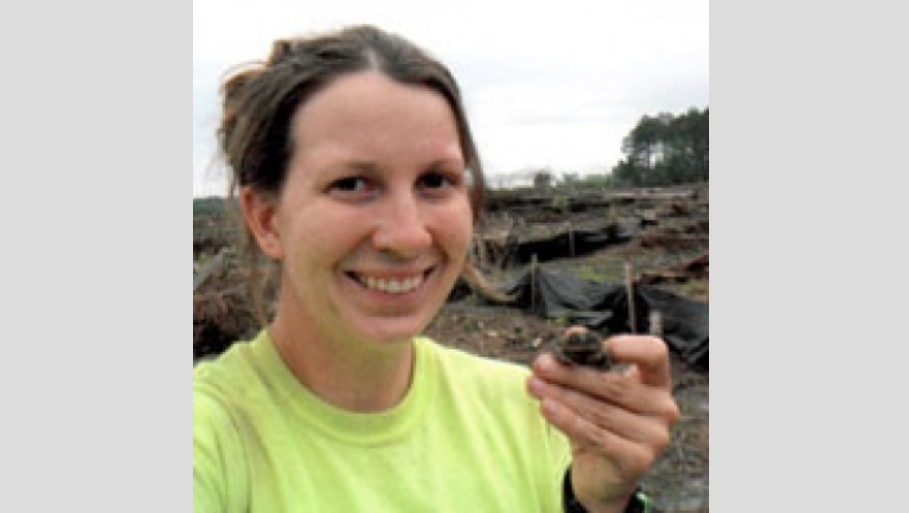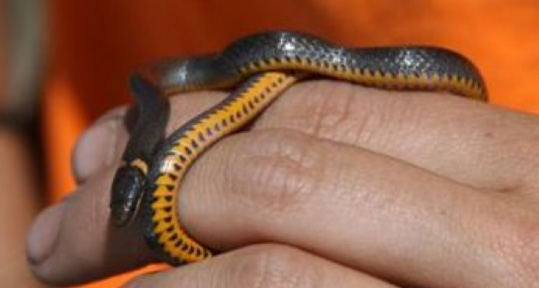Researcher Spotlight – Sarah Fritts

2012-2013 Global Change Fellow
PhD student, Department of Forestry and Environmental Resources Fisheries, Wildlife, and Conservation Biology Program
Co-Advisors: Chris Moorman & Dennis Hazel, Department of Forestry and Environmental Resources
Every year the Southeast Climate Adaptation Science Center funds a multi-disciplinary cohort of Global Change Fellows representing colleges across NC State University. Here are some highlights about 2012-13 Fellow, Sarah Fritts, and the applied research she’s conducting.
My research focus is on alternative energy and wildlife. Specifically, I study population responses of amphibians, reptiles and small mammals to woody biomass harvests. Woody biomass has substantial potential to provide renewable energy, heat, and biofuels to meet United States’ mandates such as the Energy Independence and Security Act of 2007 and Renewable Energy Standards. Although economic and environmental benefits exist in replacing coal and petroleum-based products with renewable sources, harvesting woody biomass for energy and fuel production could lead to environmental changes. Downed woody debris (DWD) is important for a variety of forest ecosystem services including wildlife habitat. Wildlife use DWD for nesting, feeding, travel, and refugia.
I monitor wildlife population responses to varying volumes of debris retention following woody biomass harvests and the spatial allocation of retained woody debris. I use a variety of capture, tagging, and statistical techniques to estimate abundance and demographics of amphibian, reptile, and small mammal species across study sites in the southeastern coastal plain. Furthermore, I am using passive implant transponder tags and radio telemetry to gather data on fine scale use of woody debris by amphibians. I hope to use the empirical data to guide development of Biomass Harvesting Guidelines which aim to ensure the forest can support wildlife, provide clean water, sequester carbon, and protect forest soil productivity following woody biomass harvests.

Questions
How did you come to study conservation biology?
After graduating from the University of Georgia with a degree in wildlife biology and management, I worked several field jobs around the country with a variety of wildlife taxa. I then went back to school for my Master’s degree and worked with fish populations impacted by farming practices at the landscape level. I came to North Carolina State University because I wanted to continue researching ways that people could advance agricultural and forestry practices to sustain or improve wildlife populations.
What is the threat of global change that you are most concerned about?
The threat of global change that I am most concerned about is how fast the climate is changing, which is leaving little time for wildlife to adapt. The timing of natural events such as migration, reproduction, metamorphosis, and hibernation is essential for wildlife survival and evolved with the timing of all other biotic and abiotic processes in the ecosystem. Climate change, however, is affecting the timing of some species’ life events which could result in a lack of food or other resources and increased predation and/or competition and during critical life-history stages.
What is the most unusual “tool” you use in your research?
The most unusual tools I use in my research probably are toad belts that I make with copper wire and PVC tubing. I attach radio transmitters by fitting each toad with a custom-made belt. I have been to numerous craft and home improvement stores searching for materials that will be robust to inclement field conditions while remaining non-abrasive to amphibian skin. Explaining to the store assistants my plans for the materials always results in very inquisitive expressions.
Where did you grow up? What was the ecological environment like around you when you were growing up?
I grew up in a neighborhood south of Atlanta and was always outside catching frogs and snakes and climbing trees. When I was small, I often rehabilitated wildlife that had been injured by cars or neighborhood pets. My father and grandfather regularly took me fishing, and my uncle and I went on numerous camping trips in the Appalachian Mountains. I continued spending a lot of time outdoors through high school and college before finding the wildlife biology and management degree program.
Do you have a species whose fate you are particularly attached to or concerned about?
 I do not have a particular species whose fate I am particularly concerned about because all species are intertwined and important components of their ecosystems. However, as ectotherms, amphibian and reptile distribution, diversity, and activity are more limited by temperature than those for endothermic species. Amphibians and reptiles have evolved temperature optima based on exposure to surrounding temperatures; and therefore, likely will be more sensitive to climatic change than other wildlife taxa. Although several factors contribute to declines of amphibians and reptiles, issues associated with climate change are leading causes.
I do not have a particular species whose fate I am particularly concerned about because all species are intertwined and important components of their ecosystems. However, as ectotherms, amphibian and reptile distribution, diversity, and activity are more limited by temperature than those for endothermic species. Amphibians and reptiles have evolved temperature optima based on exposure to surrounding temperatures; and therefore, likely will be more sensitive to climatic change than other wildlife taxa. Although several factors contribute to declines of amphibians and reptiles, issues associated with climate change are leading causes.
- Categories:
